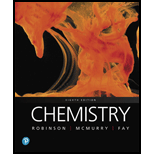
(a)
Interpretation:
The position of solid, liquid and vapor in phase diagram should be determined.
Concept introduction:
Phase diagram is a graph that represents the solid phase, liquid phase, and gaseous phase of one substance or mixture of substance under different states of temperature and pressure.
The temperature and pressure on a phase diagram at which gas, liquid, and solid phases coexist is called triple point. The temperature and pressure in the phase diagram at which substance is lies between liquid-gas phases is called critical point. The temperature and pressure at which liquid or gas is neither a true liquid nor a true gas is called supercritical point.
(b)
Interpretation:
The number of triple point of carbon should be determined. Also, the triple point in phase diagram should be circled.
Concept introduction:
Phase diagram is a graph that represents the solid phase, liquid phase, and gaseous phase of one substance or mixture of substance under different states of temperature and pressure.
The temperature and pressure in the phase diagram at which substance is lies between liquid-gas phases is called critical point. The temperature and pressure at which liquid or gas is neither a true liquid nor a true gas is called supercritical point.
(c)
Interpretation:
The graphite phase on the diagram should be identified.
Concept introduction:
Phase diagram is a graph that represents the solid phase, liquid phase, and gaseous phase of one substance or mixture of substance under different states of temperature and pressure.
The temperature and pressure in the phase diagram at which substance is lies between liquid-gas phases is called critical point. The temperature and pressure at which liquid or gas is neither a true liquid nor a true gas is called supercritical point.
d)
Interpretation:
The diamond phase on the diagram is to be identified.
Concept introduction:
Phase diagram is a graph that represents the solid phase, liquid phase, and gaseous phase of one substance or mixture of substance under different states of temperature and pressure.
The temperature and pressure in the phase diagram at which substance is lies between liquid-gas phases is called critical point. The temperature and pressure at which liquid or gas is neither a true liquid nor a true gas is called supercritical point.
(e)
Interpretation:
Whether the graphite or diamond phase that is more denser should be determined.
Concept introduction:
Phase diagram is a graph that represents the solid phase, liquid phase, and gaseous phase of one substance or mixture of substance under different states of temperature and pressure.
The temperature and pressure in the phase diagram at which substance is lies between liquid-gas phases is called critical point. The temperature and pressure at which liquid or gas is neither a true liquid nor a true gas is called supercritical point.
The density of phase is determined by temperature and pressure of the phase in the phase diagram. The phase that lies in high pressure and low temperature range is more dense.
Want to see the full answer?
Check out a sample textbook solution
Chapter 11 Solutions
CHEMISTRY-W/MASTERING CHEMISTRY ACCESS
- help 20arrow_forwardProvide the drawing of the unknown structure that corresponds with this data.arrow_forward20.44 The Diels-Alder reaction is not limited to making six-membered rings with only car- bon atoms. Predict the products of the following reactions that produce rings with atoms other than carbon in them. OCCH OCCH H (b) CH C(CH₂)s COOCH མ་ནས་བ (c) N=C H -0.X- (e) H C=N COOCHS + CH2=CHCH₂ →→arrow_forward
- 3) Draw a detailed mechanism and predict the product of the reaction shown? 1) EtMgBr 2) H3O+arrow_forwardHow to draw the mechanism for this reaction?arrow_forward> H₂C=C-CH2-CH3 B. H₂O Pt C. + H2 + H₂O H D. 16. Give the IUPAC name for each of the following: B. Cl Cl c. Cl Cl 17. Draw the line-angle formula for each of the following compounds: 1. phenol 2. 1,3-dichlorobenzene 3. 4-ethyltoluene < Previous Submit Assignment Next ▸arrow_forward
 Chemistry by OpenStax (2015-05-04)ChemistryISBN:9781938168390Author:Klaus Theopold, Richard H Langley, Paul Flowers, William R. Robinson, Mark BlaserPublisher:OpenStax
Chemistry by OpenStax (2015-05-04)ChemistryISBN:9781938168390Author:Klaus Theopold, Richard H Langley, Paul Flowers, William R. Robinson, Mark BlaserPublisher:OpenStax Chemistry & Chemical ReactivityChemistryISBN:9781133949640Author:John C. Kotz, Paul M. Treichel, John Townsend, David TreichelPublisher:Cengage Learning
Chemistry & Chemical ReactivityChemistryISBN:9781133949640Author:John C. Kotz, Paul M. Treichel, John Townsend, David TreichelPublisher:Cengage Learning Chemistry: The Molecular ScienceChemistryISBN:9781285199047Author:John W. Moore, Conrad L. StanitskiPublisher:Cengage Learning
Chemistry: The Molecular ScienceChemistryISBN:9781285199047Author:John W. Moore, Conrad L. StanitskiPublisher:Cengage Learning ChemistryChemistryISBN:9781305957404Author:Steven S. Zumdahl, Susan A. Zumdahl, Donald J. DeCostePublisher:Cengage Learning
ChemistryChemistryISBN:9781305957404Author:Steven S. Zumdahl, Susan A. Zumdahl, Donald J. DeCostePublisher:Cengage Learning General Chemistry - Standalone book (MindTap Cour...ChemistryISBN:9781305580343Author:Steven D. Gammon, Ebbing, Darrell Ebbing, Steven D., Darrell; Gammon, Darrell Ebbing; Steven D. Gammon, Darrell D.; Gammon, Ebbing; Steven D. Gammon; DarrellPublisher:Cengage Learning
General Chemistry - Standalone book (MindTap Cour...ChemistryISBN:9781305580343Author:Steven D. Gammon, Ebbing, Darrell Ebbing, Steven D., Darrell; Gammon, Darrell Ebbing; Steven D. Gammon, Darrell D.; Gammon, Ebbing; Steven D. Gammon; DarrellPublisher:Cengage Learning Principles of Modern ChemistryChemistryISBN:9781305079113Author:David W. Oxtoby, H. Pat Gillis, Laurie J. ButlerPublisher:Cengage Learning
Principles of Modern ChemistryChemistryISBN:9781305079113Author:David W. Oxtoby, H. Pat Gillis, Laurie J. ButlerPublisher:Cengage Learning





